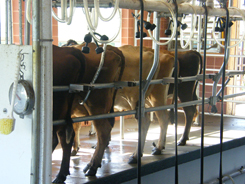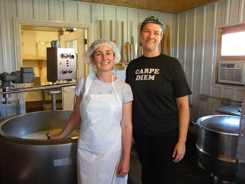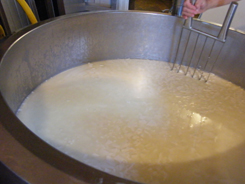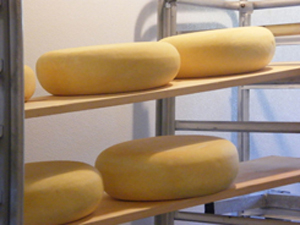
We love food, especially food that is produced by people we know.
The Idea
In 2003 a set of friends sat down to dinner to have a good visit and left with an amazing idea. Krista Dittman, Charuth Van Beuzekom-Loth and their husbands Doug and Kevin had been friends for several years and each couple was producing products off their own farms: Branched Oak Farm and ShadowBrook Farm. The conversation turned to trying something new, which led hashing out the details of opening a joint farmstead cheese business.
Stage one was looking into writing a grant to help fund the startup business. This was followed by fine tuning the cooperatively-owned business model and finally, getting some advice. When Dittman and Van Beuzekom-Loth started their research into farmstead cheese producers in 2004 there was only one producer in Nebraska. As of 2010 there are four major cheese producers in Nebraska and several of them opened in the last five years.
Since 2004, Dittman and Van Beuzekom-Loth have visited 28 cheese plants in six states and three countries, including Italy and Holland, to gain inside information and tips from other cheese producers. Dittman said the best information they’ve ever received was from other farmers and cheese makers because “they understand the business and the process”.
After the initial research the two started contacting local organizations. Some of the original contacts were: Center for Applied Rural Innovation (CARI), Nebraska EDGE® Program sponsored by Community Development Resources (CDR), the UNL Food Processing Center, and the Nebraska Cooperative Development Center (NCDC). Dittman worked with Elaine Cranford, Cooperative Business Development Specialist at NCDC, with whom she worked on the board of Nebraska Sustainable Ag Society (NSAS). Cranford offered NCDC’s help with applying for a grant and writing the initial business plan.
Dittman said she was glad they contacted several different organizations because she doesn’t think any single organization can provide every resource a person is looking for, but the ones in Lincoln work well together. Farmstead First received assistance with business planning and structure, direction and Board of Director training through NCDC, along with entrepreneur workshops hosted by the Nebraska EDGE® Program.
In 2004 Farmstead First received a Sustainable Agriculture Research & Education (SARE) grant for start-up costs along with a micro-grant for technical cheese making for farmstead cheese makers and a USDA Value-Added Producer grant.
The Business & Products
In May 2006 Branched Oak Farm started the cheese making process, followed by ShadowBrook Farm in August 2006. Both individual farms were working out of a pilot plant in Lincoln through the University of Nebraska—Lincoln.
In October 2006 Farmstead First was officially open for business as they began making cheese in their own plant as a join effort between both farms.
The idea of operating Farmstead First as a cooperatively-owned business was always the plan for Dittman and Van Beuzekom-Loth, but Dittman said that working with partners always brings other aspects into the equation. Her advice to anyone looking into starting a similar business venture is to keep track of your contributions, articulate areas of expertise and responsibility and always remember to be forgiving and flexible.
“We were always learning new things: equipment, sanitation procedures, production issues, facilities, regulations, money; and we’re still learning.”
-Krista Dittman
Part of operating a farmstead cheese operation is understand the rules and regulations at the local, state and federal levels. For Dittman and Van Beuzekom-Loth this included the USDA and state dairy regulations. Dittman referred to them both as ‘feasible’. She said when they were first starting it all seemed intimidating but now she’s really thankful for Nebraska’s dairy inspectors. “I really think they’re trying to encourage and promote dairy, but they’re also protecting the food system.” said Dittman.
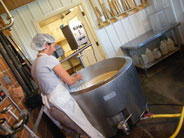
The two farms have remained the sole partners in Farmstead First since they started producing, but they have rented out equipment and space to other groups. Clover Cove has worked with Farmstead First in the past, along with Sarah Pinet, who has now opened her own farmstead business. Currently Dittman and Van Beusekom-Loth are in the process of working out possible rental time for the Farmstead First facility with a couple women who are interested in making yogurt.
Dittman said sharing equipment and space between the two farms is not always a perfect situation but they’ve always made the best of it. Scheduling is sometimes hard but otherwise they have never had any serious problems; especially since they are on the “same page for cleanliness”. Dittman also said the best part about operating Farmstead First is the good relationship she has with Van Beuzekom-Loth.
“When one [of us] is down the other is usually up. We have added inspiration and the ability to learn from each other.”
-Krista Dittman
Along with renting out equipment Farmstead First hosts classes throughout the year for interested groups, mainly: other small dairy producers, food hobbyists and chefs. The classes are hosted by individual arrangement and the provided material depends on the type of group.
Farmstead First produces artisan cheeses from Jersey cow milk produced on Branched Oak Farm and goat milk cheeses from Saanan, Alpine, Nubian, Lamancha and Toggenberg goats from ShadowBrook Farm’s Dutch Girl Creamery. The cows are in milking season from April to November and the goats are in milking season from February to December.
Dittman speculated that their overall gross income from cheese sales has grown about 30% every year, but she’s not expecting 2010 to be as dramatic. They are currently looking into ways to increase their net profit by reducing their input costs.
“You have to run your farm as a business, you know your numbers and you know what you’ve got.”
-Krista Dittman
The Challenges & Changes
Dittman and Van Beuzekom-Loth knew working as a cooperatively-owned business would allow them to share the start-up cost of equipment and the cost of employees, but they still faced challenges.
One of their first challenges occurred right after they opened the Farmstead First plant. After being open only six weeks the cows and goats dried off and the two were forced to wait until the next milking season to begin again. Dittman said that keeping up with the learning curve both technologically and philosophically was their biggest challenge in the beginning.

Dittman stated that in recent years they haven’t had any unique challenges or setbacks, just “regular maintenance stuff”. Their only notable challenge has involved maintenance. During the past two years (2008-2010), the number of technicians in Nebraska who fix dairy equipment was cut, greatly reducing the number of available technicians in the Lincoln area. For 2010 one technician was located at Midwest Livestock in Beatrice and about five technicians in Norfolk. Dittman said this caused some problems for Van Beuzekom-Loth and herself when they needed maintenance work, equipment and supplies.
When asked about the biggest challenge of operating Farmstead First Dittman replied, “Finding a balance so I’m not working all the time. I need to find a good balance between work and maintaining energy for relationships with my family and business partner.”
This last year (2010) brought many changes to Branched Oak Farm, including letting go of their live-in intern and full-time hired man. Dittman said the intent was to increase efficiency and profitability. If Farmstead First only has to worry about paying the two owners and their helping families then more money stays on the farms.
More changes are likely to evolve in 2011 as Dittman is planning on milking during the winter season for the first time thus, changing from a seasonal milking pattern to a year-round season. Van Beuzekom-Loth is also looking into the idea, she is planning to start with a few of her goats to see how goes and “to keep some of our retail accounts happy”. Van Beuzekom-Loth is also doing some product expanding in 2011 with her Dutch Girl Creamery milk products to include yogurt and kefir (a tart-tasting drink similar to yogurt).
The Future
When asked where she thought Farmstead First would be in five to ten years Dittman answered that she had no idea. “I know it’s going to change,” said Dittman. “But I’m not even sure if it will still be around-at least not as we know it today.”
Farmstead First will have to continue to evolve as the markets change, and Dittman said they just have to see where they end up. The two are currently considering starting a second location on Van Beuzekom-Loth’s farm, which they may call Farmstead First South, but they are not certain if they’ll continue their financial arrangement of sharing the cost of equipment.
For now consumers can purchase products sold by Farmstead First, Branched Oak Farm and ShadowBrook Farm. No matter what direction the business takes, Dittman and Van Beuzekom-Loth will continue to sell good, fresh products.
